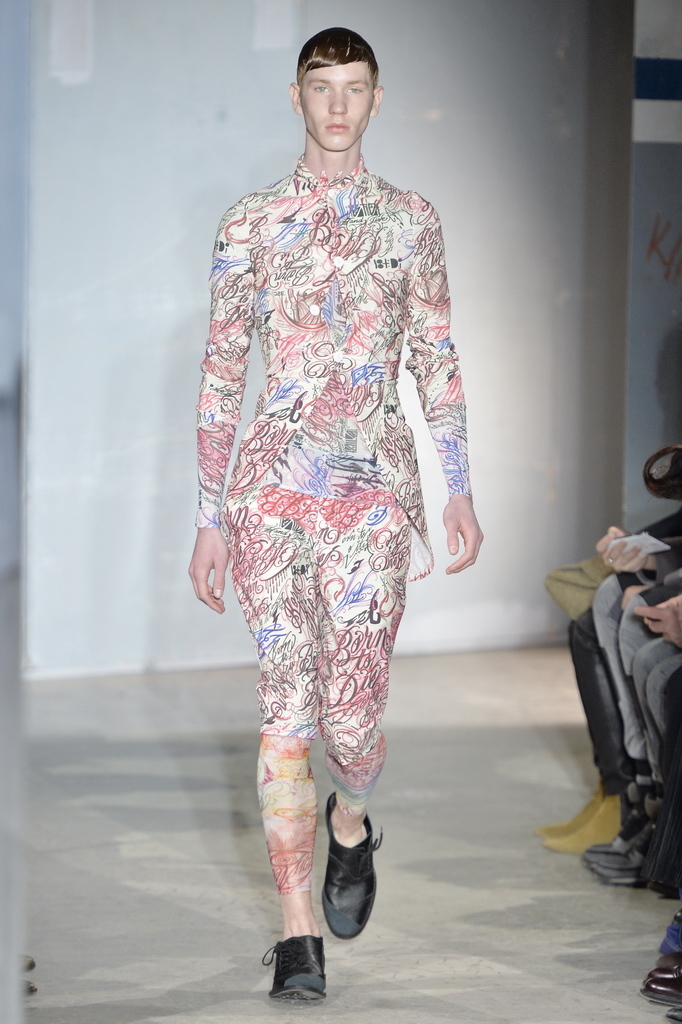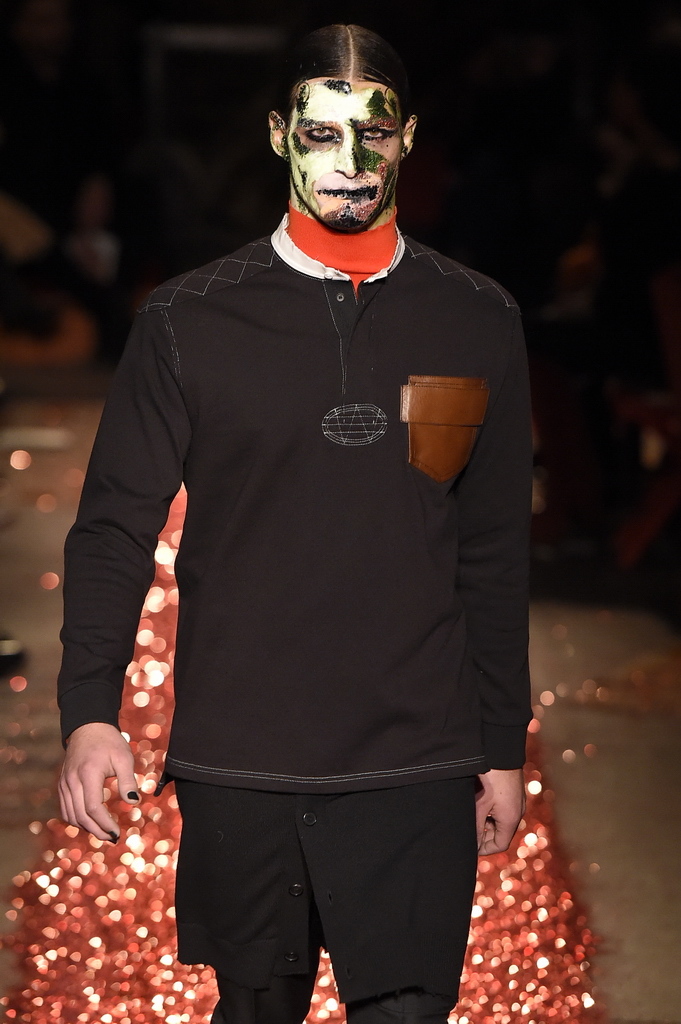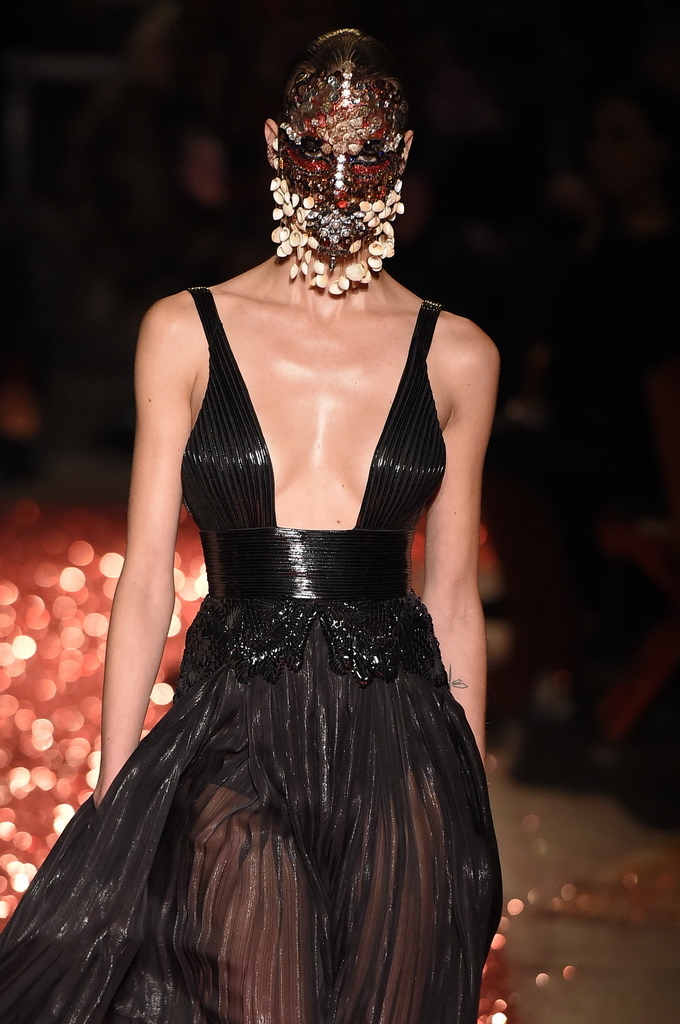By now, the uniform spirit of the autumn/winter 15 men’s shows has been firmly established, on all its many levels. There’s the literal interpretation – official costume such as military – and the more elusive idea of uniformity, but until the third day of the Paris collections, the ceremonious aspect of the uniform hadn’t been explored as expressly as it was at Comme des Garçons. The priestly robe was Rei Kawakubo’s revolving point for a sinister and exquisite collection, which focused on the darker side of ceremonial dressing. Jocelyn Pook’s spine-chilling Masked Ball chant from Eyes Wide Shut played over and over again, a monkish voice repeating a prayer in backwards Romanian. “And God told his apprentices, ‘I gave you a command: to pray to the Lord for mercy, life, peace, health, salvation; the search, the leave and the forgiveness of the sins of God’s children. The ones that pray, they have mercy and they take good care of this holy place.”‘ (Thanks, YouTube.) Not exactly optimistic fun pop, and the idea of dressing for a sect – a secret society, an obscure belief, a dangerous ritual – couldn’t have been scored better.

A print that looked like text when used in stained glass in catholic churches repeated the phrase ‘Born to die’, while larger, terrifying motifs on the backs of jackets looked like medieval engravings, seemingly depicting plague-like scenes of death and horror. Kawakubo’s collection could be seen as a comment on the cultishness of dressing in our day and age: how our style choices have turned into a kind of religious sign of devotion to the corner of the world to which we proclaim our loyalty, be it a certain tribe of people, a specific designer and his vision for the world, or indeed a religion. After all, the scary part of uniforms was always their blinding beauty, something Hitler and Mussolini both understood, and something that can be traced back to ancient Rome where warlord emperors – essentially mass murderers – were clad in breathtaking gilded armour. After her foresighted foray into military uniforms last season, Kawakubo avoided the reference for autumn/winter 15, but the ambiguity she portrayed through her priestly garments couldn’t have expressed the disturbing side to uniform dressing any better.

A similar memento mori sentiment was present at Givenchy, although Riccardo Tisci’s cult was of a somewhat more devilishly glamorous nature. “For me, today was like an esprit of things I really love, from love to death, which can be negative for some people but for me it’s really positive,” he told i-D backstage. “I come from a dark background. I’ve been obsessed with skulls since I was a baby. Any cartoon that had a skull, I was obsessed.” They were painted and embellished onto the faces of models in what he called a “poutpouri of mystic things and things I’ve been collecting all my life”. The collection had all the Central and South American heat of Tisci’s root aesthetics, but with an even darker, even more opulent gloom to it, like a kind of Day of the Dead parade that made you think of heathen dress and the costumes of shamans. “When you collect things you collect energy from other people, and energy, I think, is one of the most beautiful things the human being has,” Tisci said.

He described the collection as a “de Chirico journey”, citing the artist whose panoramic townscapes had clearly fed into the red-hot motifs, which ruled the collection. But Tisci had also found inspiration in the Mexican carpets he’s been collecting all his life – next to Venetian jewellery and “dreams,” as he said – which linked in with a certain sense of urban tribe culture, the Central American kind borrowed from old superstitious culture of the area. It was a pagan or perhaps even slightly Satanic counterpart to the cultish ceremony of the Comme des Garçons collection, and for Givenchy, whose dog and shark and Madonna images of seasons past have virtually become rocker back patches for the house’s devotees, a new priestly robe for Tisci’s disciples.

Credits
Text Anders Chrisian Madsen
Photography Mitchell Sams
